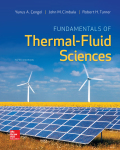
The increase in heat transfer from the tube per meter of its length.
Explanation of Solution
Given:
Thermal conductivity of the fins
Heat transfer coefficient
Space between the fins
Outer diameter of the tube
Outer diameter of the fin
Number of fins
Calculation:
Determine the surface area in case of no fins.
Determine the heat transfer in case of no fins.
Determine the length.
Determine the following factor.
Determine the following factor.
Obtain the efficiency of these circular fins from the efficiency curve of Figure 17-44 as 0.96.
Determine the area of fin.
Determine the heat transfer from a single fin.
Determine the surface area of a single unfinned portion of the tube.
Determine the heat transfer from a single unfinned portion of the tube.
Determine the total heat transfer from the finned tube.
Determine the increase in heat transfer from the tube.
Thus, the increase in heat transfer from the tube is
Want to see more full solutions like this?
Chapter 17 Solutions
EBK FUNDAMENTALS OF THERMAL-FLUID SCIEN
 Elements Of ElectromagneticsMechanical EngineeringISBN:9780190698614Author:Sadiku, Matthew N. O.Publisher:Oxford University Press
Elements Of ElectromagneticsMechanical EngineeringISBN:9780190698614Author:Sadiku, Matthew N. O.Publisher:Oxford University Press Mechanics of Materials (10th Edition)Mechanical EngineeringISBN:9780134319650Author:Russell C. HibbelerPublisher:PEARSON
Mechanics of Materials (10th Edition)Mechanical EngineeringISBN:9780134319650Author:Russell C. HibbelerPublisher:PEARSON Thermodynamics: An Engineering ApproachMechanical EngineeringISBN:9781259822674Author:Yunus A. Cengel Dr., Michael A. BolesPublisher:McGraw-Hill Education
Thermodynamics: An Engineering ApproachMechanical EngineeringISBN:9781259822674Author:Yunus A. Cengel Dr., Michael A. BolesPublisher:McGraw-Hill Education Control Systems EngineeringMechanical EngineeringISBN:9781118170519Author:Norman S. NisePublisher:WILEY
Control Systems EngineeringMechanical EngineeringISBN:9781118170519Author:Norman S. NisePublisher:WILEY Mechanics of Materials (MindTap Course List)Mechanical EngineeringISBN:9781337093347Author:Barry J. Goodno, James M. GerePublisher:Cengage Learning
Mechanics of Materials (MindTap Course List)Mechanical EngineeringISBN:9781337093347Author:Barry J. Goodno, James M. GerePublisher:Cengage Learning Engineering Mechanics: StaticsMechanical EngineeringISBN:9781118807330Author:James L. Meriam, L. G. Kraige, J. N. BoltonPublisher:WILEY
Engineering Mechanics: StaticsMechanical EngineeringISBN:9781118807330Author:James L. Meriam, L. G. Kraige, J. N. BoltonPublisher:WILEY





